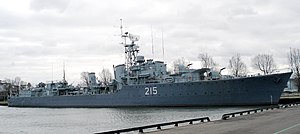Tribal-class destroyer (1936)

HMCS Haida, a Canadian Tribal-class destroyer and the only Tribal-class destroyer to be preserved
|
|
| Class overview | |
|---|---|
| Builders: | |
| Operators: | |
| Preceded by: | I class |
| Succeeded by: | J class |
| In commission: | 1938–63 |
| Planned: | 31 |
| Completed: | 27 |
| Cancelled: | 4 |
| Lost: | 14 |
| Scrapped: | 12 |
| Preserved: | 1 |
| General characteristics | |
| Type: | Destroyer |
| Displacement: | |
| Length: | 377 ft (115 m) (o/a) |
| Beam: | 36 ft 6 in (11.13 m) |
| Draught: | 11 ft 3 in (3.43 m) |
| Installed power: |
|
| Propulsion: | 2 × shafts; 2 × geared steam turbines |
| Speed: | 36 knots (67 km/h; 41 mph) |
| Range: | 5,700 nmi (10,600 km; 6,600 mi) at 15 knots (28 km/h; 17 mph) |
| Complement: | 190 (219 in flotilla leaders) |
| Sensors and processing systems: |
ASDIC |
| Armament: |
|
The Tribal class, or Afridi class, were a class of destroyers built for the Royal Navy, Royal Canadian Navy and Royal Australian Navy that saw service in World War II. Originally conceived during design studies for a light fleet cruiser, the Tribals evolved into fast, powerful destroyers, with greater emphasis on guns over torpedoes than previous destroyers, in response to new designs by Japan, Italy, and Germany. The Tribals were well admired by their crews and the public when they were in service due to their power, often becoming symbols of prestige while in service.
As some of the Royal Navy's most modern and powerful escort ships, the Tribal class served with distinction in nearly all theatres of World War II. Only a handful of Royal Navy Tribals survived the war, all of which were subsequently scrapped from hard use, while Commonwealth Tribals continued to serve into the Cold War, serving with distinction in the Korean War. Only one Tribal survives to this day: HMCS Haida, which is now a museum ship in Hamilton Harbour, Ontario, Canada.
From 1926, all Royal Navy destroyers had descended from a common lineage based upon the prototypes Amazon and Ambuscade. During the interwar period, advances in armament and machinery meant that by the mid-1930s, these "interwar standard" destroyers were being eclipsed by foreign designs, particularly from Japan, Italy, and Germany. To counteract this trend, the Admiralty decided on a new destroyer type, with an emphasis on gunnery over torpedo warfare. The destroyer was based on 'Design V', a design study for a small fleet cruiser (another variant of this design evolved into the Dido-class cruiser). This design envisioned a 1,850-ton ship with a speed of 36.25 knots (67.14 km/h; 41.72 mph), an endurance of 5,500 nautical miles (10,200 km; 6,300 mi), and five twin 4.7 inch guns as main armament.
...
Wikipedia
